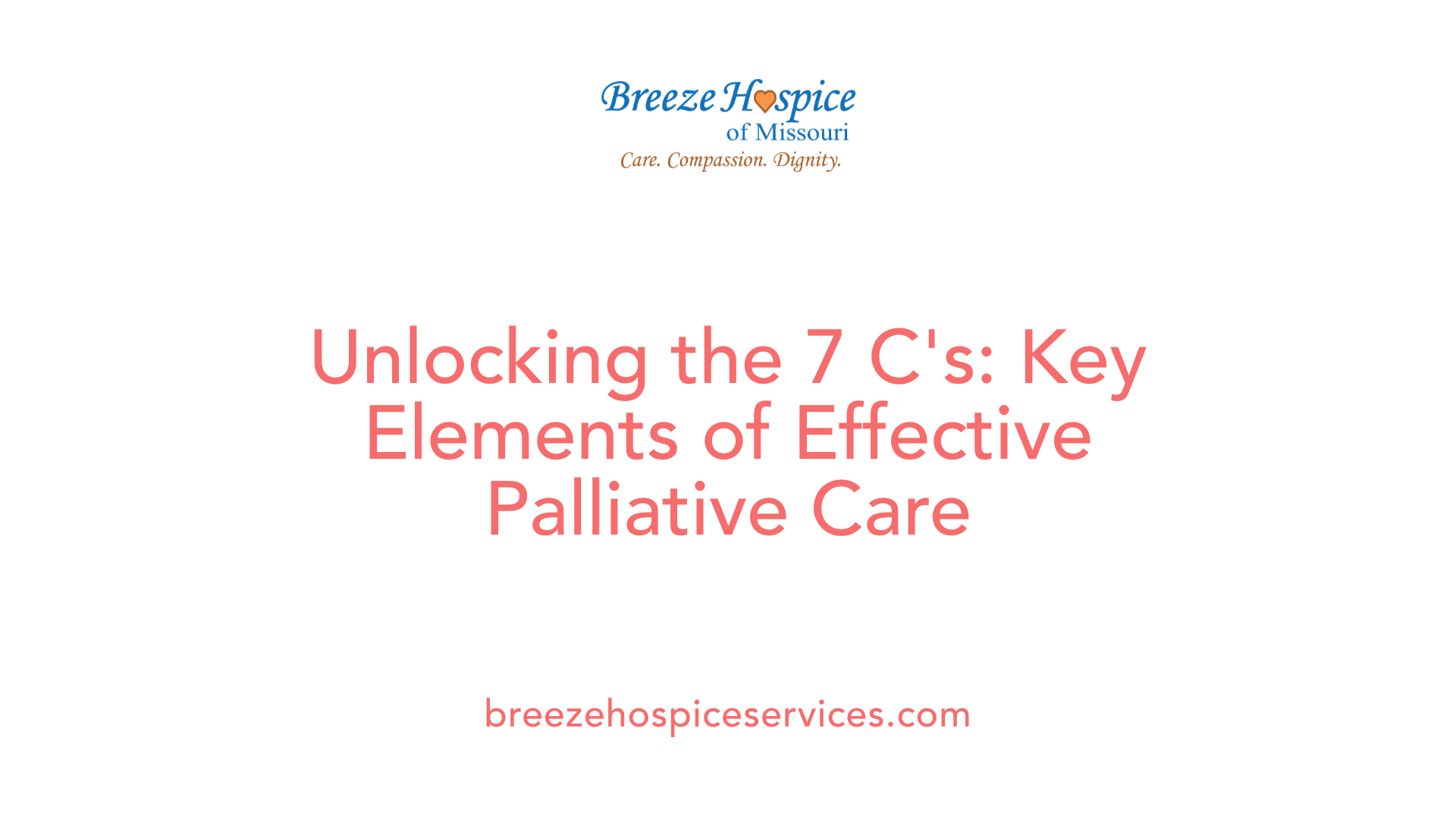Developing Hospice Care Policies
April 1, 2025
Blueprints for Compassionate End-of-Life Care

Introduction to Developing Hospice Care Policies
Hospice care policies form the crux of quality end-of-life support, addressing crucial patient needs while navigating regulatory frameworks. Developing these policies involves a comprehensive understanding of both the sentimental and legislative landscapes that govern hospice and palliative care services. This article sketches out insights essential for creating effective hospice care policies that balance compassionate caregiving with legal compliance and evolving healthcare standards.
Priorities in Hospice Patient Care

What are the 5 priorities of care for hospice patients?
The five priorities of care for hospice patients are essential to ensuring their comfort and dignity in their final days:
Medical Care
Medical care focuses on managing symptoms and providing necessary treatments, such as medication for pain relief and symptom management. The interdisciplinary group of care professionals collaborates to enhance quality of life for patients facing terminal illness.Personal Care
Personal care involves assisting patients with daily activities such as bathing, dressing, and personal hygiene. This respectful and compassionate support meets the holistic needs of patients, addressing their physical and emotional well-being.Pain Management
Pain management is a critical component of hospice care. It employs various methods and medications, such as opioids or alternative therapies, aimed at relieving discomfort, enhancing patients' overall experience, and ensuring they remain as comfortable as possible.Counseling
Counseling offers emotional support not only to patients but also to their families. This helps them cope with the unique challenges of end-of-life issues, making the process more manageable and less distressing for everyone involved.End-of-Life Planning
End-of-life planning ensures that a patient's wishes regarding their care and legacy are honored. This may include discussions about advanced directives and preferences for posthumous arrangements, ensuring that care aligns with the individual’s values and desires.
These priorities work in concert to provide a comprehensive and compassionate approach to hospice care, ensuring safety, comfort, and dignity for patients and their families.
Understanding the 7 C's of Palliative Care

What are the 7 C's of palliative care?
The 7 C's of palliative care are fundamental elements crucial for delivering high-quality end-of-life care. They ensure that each aspect of patient and family needs is effectively met throughout the palliative process.
Communication: Maintaining a supportive care register is vital for effective discussions among healthcare teams. This ensures everyone is aware of the patient's condition and preferences.
Coordination: A designated lead healthcare professional, like a district nurse, is essential to manage care and facilitate collaborative meetings among the interdisciplinary group, promoting teamwork and unified patient care.
Control of Symptoms: This involves regular assessments and proactive management of symptoms to enhance comfort. Addressing pain and other distressing symptoms is at the heart of palliative care.
Continuity: Ensuring seamless transitions between different care levels and specialists is critical. This guarantees that all caregivers are informed and that patients experience consistent care as their needs change.
Continued Learning: Encouraging the sharing of experiences across the care team helps to refine practices. Ongoing education keeps providers informed about new techniques and treatments.
Carer Support: Supporting caregivers is essential, as they play a crucial role in patient well-being. This includes providing resources and assistance to lessen their burdens.
Care in the Dying Phase: Preparing families for the dying process is key. This aspect of care focuses on ensuring that patients experience dignity and comfort in their final days.
These seven components guide care teams in providing holistic and effective palliative care, ultimately enhancing the quality of life for patients and their families.
Barriers to Accessing Hospice Care

What are three barriers to hospice care?
Accessing hospice care can be particularly challenging for many patients and families. Below are a few key barriers that often complicate this process:
Lack of Information
Many individuals are unaware of what hospice care entails or the comprehensive benefits it offers. The absence of clear communication about services can lead to delays and reluctance in seeking care.Misunderstanding
Common misconceptions about hospice, such as it being only for the very last days of life, prevent earlier access. People may not realize hospice care can significantly enhance quality of life well before the end stages of a terminal illness.Financial Limitations
Even though Medicare covers hospice services, complexities in billing and eligibility criteria can deter families. Concerns about out-of-pocket expenses may cause patients to delay initiation, even when they qualify.Fear
A significant emotional barrier arises from fear—fear of death, fear of pain, and fear of losing control over treatment options. This often inhibits families from choosing hospice even when it might align best with their needs.
In addressing these barriers, effective communication and education about hospice can pave the way for broader acceptance and utilization of these essential services.
Essential Components of Hospice Care Policies

What are essential components of hospice care policies?
Essential components of hospice care policies revolve around the creation and implementation of an individualized plan of care (POC) for each patient facing terminal illnesses. This plan must delineate specific needs and actionable services tailored to both the patient and their family caregivers.
Individual Plan of Care (POC)
The POC should include:
- Patient and Family Goals: Clearly defined objectives that reflect the desires and preferences of both patients and their families.
- Interventions and Treatments: Detailed descriptions of necessary steps for symptom relief and management of care.
- Medications and Supplies: Requirements for medications and medical supplies necessary for optimal patient care.
- Expected Outcomes: Measurable results that can be tracked and reviewed throughout the course of care.
The POC is formulated by an Interdisciplinary Group (IDG), which must be led by a Registered Nurse as a coordinator. This group includes doctors, social workers, and other relevant personnel who work collaboratively to ensure comprehensive support.
Review and Adjustment of Care
The individualized POC is not static; it should be reviewed and revised at least every 15 days. This ongoing evaluation ensures that the plan adapts to the changing needs of the patient and that relevant objectives are met promptly.
Regulatory Compliance
Hospice care policies must also strictly adhere to regulatory standards that guide service delivery. Compliance with these regulations is crucial in maintaining hospice program certification. Each hospice must implement a system for constant communication among care providers, ensuring coordinated management of patient care.
Holistic Care Approach
Policies must underscore the importance of holistic care that incorporates:
- Physical Needs: Addressing medical requirements.
- Emotional Support: Providing mental health assistance.
- Psychosocial Considerations: Facilitating social interaction and relationships.
- Spiritual Care: Attending to the spiritual dimensions of patient care, a vital aspect emphasized since the establishment of hospice principles.
In summary, effective hospice care policies prioritize a tailored POC within a framework of regulated standards and holistic approaches, ensuring that both patients and their families receive compassionate, comprehensive care during challenging times.
The 2025 Hospice Final Rule: Key Updates

What are the new hospice regulations for 2025?
The 2025 Hospice Final Rule, set to take effect on October 1, 2024, brings several significant updates aimed at improving hospice care and ensuring better compliance with quality standards.
Key Changes in Reimbursement Rates
- Base Rate Increase: Hospice levels of care will see a 2.9% increase in reimbursement rates.
- Annual Payment Cap: The annual cap on payments will now be adjusted to $34,465.34, providing hospices with a clearer financial framework.
Quality Reporting Adjustments
- Reduced Rates for Non-Compliance: Hospices that fail to meet the established quality reporting thresholds will experience a 4% reduction in their reimbursement rates. This incentive aims to prioritize high-quality care and accountability within hospice services.
Enhanced Certification Process
- Medical Director Certification: The new regulations allow either the Medical Director or designated physicians to certify a patient's terminal illness. This change streamlines the certification process, making it more efficient for both healthcare providers and patients.
- Introduction of HOPE Assessment Tool: The Health Outcomes Patient Evaluation (HOPE) tool will be implemented to replace the previous Hospice Item Set. This tool focuses on regular data collection, enhancing the quality of care provided in hospice settings.
These updates reflect an ongoing commitment to improving hospice services and ensuring that care providers meet the evolving needs of patients at the end of life.
Role of Interdisciplinary Teams in Hospice Care
IDG Composition
The Interdisciplinary Group (IDG) plays a critical role in hospice care by ensuring a holistic approach to patient well-being. Composed of various health professionals, including physicians, registered nurses, social workers, and pastoral counselors, the IDG brings together diverse expertise. This diversity helps address the physical, emotional, spiritual, and psychosocial needs of both patients and their families.
Plan of Care Oversight
One of the IDG's primary responsibilities is to develop and oversee the Plan of Care (POC) for each patient. This individualized plan must include interventions for pain and symptom management, medications, and documentation confirming the patient's or their representative's understanding of the care plan. Regular reviews of the POC are essential, with assessments occurring at least every 15 days to ensure appropriate adjustments are made based on the patient’s evolving needs.
Coordinated Care
Effective care coordination is paramount within hospice settings. The IDG facilitates communication among all care providers, ensuring that services align with the POC. This collaboration helps manage care effectively and share critical information, resulting in a more seamless patient experience. By working cohesively, the team enhances the quality of care and supports the overarching goal of comfort and dignity in the final stages of life.
| Topic | Description | Importance |
|---|---|---|
| IDG Composition | Composed of various health professionals | Ensures holistic addressing of patient needs |
| Plan of Care Oversight | Development and regular review of individualized POC | Maintains focus on pain and symptom management |
| Coordinated Care | Communication and coordination among care providers | Enhances patient experience and ensures seamless care |
Regulatory Frameworks Influencing Hospice Policy
Medicare Hospice Benefit
The Medicare Hospice Benefit provides crucial support for patients with terminal illnesses, requiring them to be certified as terminally ill with a prognosis of six months or less. Eligible patients must sign an election statement, waiving their rights to Medicare payment for their terminal illness and other related conditions. This coverage includes services from medical professionals, nursing care, medications for pain management, and counseling services.
Certifying Terminal Illness
The process of certifying terminal illness is vital for hospice eligibility. Physicians must provide documentation indicating that the patient is likely to live six months or less if the illness follows its normal course. Regular recertification is required during each election period to ensure compliance and continued care, underscoring the necessity for thorough assessments throughout the hospice journey.
State and Federal Regulations
Hospice services operate within a defined regulatory framework established by state and federal laws. The administrative home of a hospice program determines how policies and procedures meet these regulations, ensuring quality and compliance in care delivery. Specific conditions of participation include having a medical director, maintaining an infection control plan, and fulfilling timely patient assessments. As regulations evolve, hospice organizations must remain adaptable, promoting equitable access and high-quality care to meet the needs of patients and families.
Impact of Legislative Initiatives on Hospice Care
What is the Palliative Care and Hospice Education and Training Act (PCHETA)?
The Palliative Care and Hospice Education and Training Act (PCHETA) plays a crucial role in enhancing the quality of palliative care education by increasing the number of trained professionals in accredited programs. By emphasizing the importance of training, PCHETA addresses the growing need for knowledgeable healthcare providers in end-of-life care. This effort aims to prepare practitioners for better outcomes in hospice scenarios, ensuring that both patients and families receive appropriate support during challenging times.
How does the Compassionate Care Act make a difference?
The Compassionate Care Act aims to improve advance care planning and seeks to address gaps in hospice Medicare coverage. By promoting patient autonomy in decision-making, this act ensures that patients' wishes about their care preferences are respected. Additionally, it aims to secure a more robust framework to guide the delivery of hospice services, as well as enhance understanding among patients regarding their care options.
What are the implications of expanding hospice eligibility?
One of the most frequently cited strategies for increasing access to hospice care is expanding eligibility criteria under the Medicare Hospice Benefit. Currently, the requirement that patients must be terminally ill with a prognosis of six months or less poses significant barriers. A shift towards a needs-based criterion could integrate hospice services earlier in the patient journey, potentially simplifying referral processes and promoting timely care. This approach would ensure that a broader segment of patients benefit from hospice services, aligning with their evolving care needs.
Ethical Standards and Practices in Hospice Care
Organizational Ethics
Organizational ethics form the bedrock for providing quality hospice care, ensuring that care delivery aligns with core values such as transparency, integrity, and comfort. Guidelines, like those established by the NHPCO, advocate for practices that respect both patients and their families, focusing on family-centered care and the nature of suffering, thereby setting ethical standards that all hospice programs should strive to meet.
Patient Autonomy
Patient autonomy is pivotal in hospice care, granting individuals the right to be involved in the development of their care plans. This includes understanding the implications of their choices and the ability to refuse treatment. Such principles empower patients, allowing them to maintain control during a vulnerable phase of life, which is crucial to ethical hospice practices.
Cultural Competency
Cultural competency is vital in hospice care policies, ensuring that care is respectful of and tailored to diverse cultural backgrounds and values. Addressing variations in hospice utilization across different races and ethnicities is essential for equitable access to services. Policies must include training that enhances the cultural awareness of staff, promoting an inclusive environment that recognizes and honors the unique needs of each patient.
Frameworks and Models for Evidence-Based Hospice Care
Clinical Practice Guidelines
The development of evidence-based clinical practice guidelines is crucial in hospice care. These guidelines provide standardized approaches that ensure patients receive high-quality and consistent care tailored to their specific needs. For example, the Clinical Practice Guidelines for Quality Palliative Care set out protocols that all hospice providers can follow, ensuring equity and quality in service delivery regardless of patient demographics.
Quality Metrics
Quality metrics are essential tools for assessing the effectiveness of hospice care programs. They include measurements such as patient satisfaction, care coordination, and symptom management effectiveness. Organizations like the National Committee for Quality Assurance are instrumental in developing these metrics, providing benchmarks that hospices can use to evaluate and improve service delivery.
Data-Driven Policy Development
Using data to inform policy development is a strategic approach that can enhance hospice care frameworks. By analyzing trends in patient needs and outcomes, stakeholders can address gaps in service and develop targeted interventions. Moreover, advocacy for data collection practices within the hospice sector can lead to funding opportunities and resources necessary for program enhancements.
| Aspect | Importance | Example |
|---|---|---|
| Clinical Practice Guidelines | Standardizes high-quality patient care | Protocols for pain management |
| Quality Metrics | Measures effectiveness and patient satisfaction | Surveys on symptom control and emotional support |
| Data-Driven Policies | Informs strategic decisions for program development | Analyzing patient demographics for service allocation |
Navigating the Complexities of Hospice Eligibility Criteria
Medicare Eligibility
To be eligible for Medicare hospice benefits, patients must be deemed terminally ill, with a life expectancy of six months or less. This determination is crucial, as patients must also sign an election statement to waive rights to Medicare benefits related to their terminal illness. Specific regulations govern this, which are outlined in the Social Security Act and the Code of Federal Regulations.
Prognostic Challenges
One of the significant barriers to accessing hospice care is accurately predicting a patient’s prognosis. Many patients do not receive referrals in time due to uncertainties in prognosis. Given the strict six-month timeframe, healthcare providers often find themselves hesitant to make definitive statements about life expectancy, complicating the referral and enrollment process.
Needs-Based Criteria
There is ongoing discussion around shifting from a prognosis-based to a needs-based eligibility criterion. By expanding access earlier in the illness trajectory, hospice services could integrate more effectively with curative treatment options and better meet patient needs. This policy shift could ensure that patients receive necessary comfort and support sooner, thus enhancing the quality of life for those facing serious illnesses.
Conclusion: Building Compassionate Care Policies
Developing effective hospice care policies demands a nuanced balance of compassionate care with regulatory adherence, ensuring dignity and quality through the terminal stages of life. By focusing on patient needs and inclusive, evidence-based practices, these policies can manage not only to be compliant with current laws but also adaptable to future developments in healthcare legislation and ethics. As the landscape of hospice care advances, so too must the policies that support those most vulnerable, ensuring all patients receive the comprehensive care they deserve.
References
- [PDF] MLN9895410 Creating An Effective Hospice Plan of Care - CMS
- [PDF] Policies and Procedures - NHPCO
- Hospice Care - StatPearls - NCBI Bookshelf
- Hospice Care Regulations and Laws - FindLaw
- [PDF] Guide to Organizational Ethics in Hospice Care - NHPCO
- Seven Ways State Policymakers Can Promote Palliative Care
- Federal Advocacy & Policy - Compassion & Choices
- Improving Access to Hospice Care: Informing the Debate - PMC


































































































